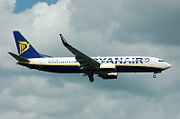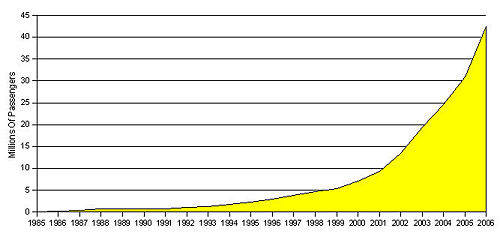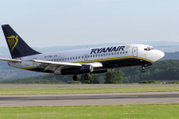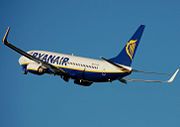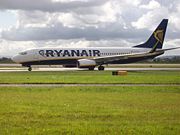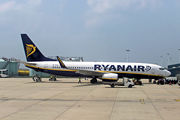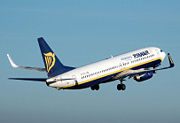Ryanair
2008/9 Schools Wikipedia Selection. Related subjects: Companies
| Ryanair | ||
|---|---|---|
 |
||
| IATA FR |
ICAO RYR |
Callsign RYANAIR |
| Founded | 1985 | |
| Focus cities |
|
|
| Fleet size | 152 plus 152 on order | |
| Destinations | 132 | |
| Headquarters | ||
| Key people | Michael O'Leary ( CEO) Michael Cawley (Deputy Chief Executive and Chief Operating Officer) |
|
| Website: http://www.ryanair.com | ||
Ryanair ( ISEQ: RYA, LSE: RYA, NASDAQ: RYAAY) is an Irish airline headquartered in Dublin, with its biggest operational base at London Stansted Airport in the UK. It is Europe's largest low-cost carrier. As of 31 July 2007, Ryanair operates 516 routes across 26 countries from 23 bases. Ryanair has been characterised by rapid expansion, a result of the deregulation of the air industry in Europe in 1997. Ryanair is the third largest airline in Europe in terms of passenger numbers.
Its supporters praise its commitment to low fares, radical management, and its willingness to challenge what it calls the 'establishment' within the airline industry (similar to its American counterpart, Southwest Airlines). Critics, meanwhile, have attacked its trade union policies, hidden "taxes" and fees, and limited customer services, and charged that it practises deceptive advertising. In October 2006, Ryanair was voted the world's most disliked airline in a survey by the TripAdvisor website, and in November 2006, it was revealed as the subject of more complaints than any other airline in the EU. The BBC reported that 56% of respondents said Ryanair caused "the biggest headaches" for air travellers in a poll taken in 2003. 60% of all complaints to Ireland's Commission for Aviation Regulation were about Ryanair. On 22 August 2007 the UK's Advertising Standards Authority upheld a complaint that Ryanair had misled the public in an advert comparing its service from London Stansted to Brussels (the airline flies to Charleroi Airport in Charleroi) with that of Eurostar. The advert stated that Ryanair's service is both quicker and cheaper, whereas the ASA concluded that Ryanair had not included the time and costs of travel to and from the airports in question in its comparison.
Financials and history
Financial overview
Ryanair has grown massively since its establishment in 1985, from a small airline flying a short hop from Waterford to London, into one of Europe's largest carriers. After taking the rapidly growing airline public in 1997 the money raised was used to expand the airline into a pan-European carrier. Revenues have risen from €231 million in 1998 to some €843 million in 2003, and net profits have increased from €48 million to €239 million over the same period.
Half year profits for the period ended October 31, 2007 included ancillary revenue of €252 million. This activity was associated with the sale of car hire, hotels, travel insurance, as well as on board sales and excess baggage revenues. Ancillary revenue now accounts for just over 16% of total revenues.
Early years
Ryanair was founded in 1985 by Cathal and Declan Ryan (after whom the company is named), Liam Lonergan (owner of an Irish tour operator named Club Travel), and noted Irish businessman Tony Ryan, founder of Guinness Peat Aviation and father of Cathal Ryan and Declan. The airline began with a 14 seat Embraer turboprop aircraft flying between Waterford and London Gatwick with the aim of breaking the duopoly on London-Ireland flights at that time held by British Airways and Aer Lingus.
In 1986 the company added a second route – flying Dublin- London Luton in direct competition to the Aer Lingus / BA duopoly for the first time. Under partial EU Deregulation, airlines could begin new international intra-EU services as long as at least one of the two governments gave approval (the so-called "double-disapproval" regime). The Irish government at the time refused its approval in order to protect Aer Lingus, but Britain, under Margaret Thatcher's pro-free-market Conservative government, approved the service. With two routes and two planes, the fledgling airline carried 82,000 passengers in one year.
Passenger numbers continued to increase, but the airline generally ran at a loss, and by 1991 was in need of restructuring. Michael O'Leary was charged with the task of making the airline profitable. Ryan encouraged him to visit the USA to study the 'low fares/no frills' model being used by Southwest Airlines. O'Leary quickly decided that the key to low fares was to implement quick turn-around times for aircraft, "no frills", and no business class, as well as operating a single model of aircraft. O'Leary returned - convinced that Ryanair could make huge inroads into the European air market, at that time dominated by national carriers which were subsidised to various degrees by their parent countries. He competed with the major airlines by providing a "no-frills", low-cost service. Flights were scheduled into regional airports, which offered lower landing and handling charges than larger established international airports. O'Leary as Chief Executive did a publicity stunts where he helped out with baggage handling on Ryanair flights at Dublin airport. By 1995, after the consistent pursuit of its low-cost business model, Ryanair celebrated its 10th birthday by carrying 2.25 million passengers.
1992 - 1999
EU deregulation of the air industry in Europe in 1992 gave carriers from one EU country the right to operate scheduled services between other EU states, and represented a major opportunity for Ryanair. After a successful flotation on the Dublin Stock Exchange and the NASDAQ Stock exchanges, the airline launched services to Stockholm, Oslo ( Sandefjord Airport, Torp, 110 km south of Oslo), Paris and Charleroi near Brussels. Flush with new capital, the airline placed a massive $2 billion order for 45 new Boeing 737-800 series aircraft in 1998.
2000-2006
The airline launched its website in 2000, with online booking initially said to be a small and unimportant part of the software supporting the site. Increasingly the online booking contributed to the aim of cutting flight prices by selling direct to passengers and excluding the costs imposed by travel agents. Within a year the website was handling three-quarters of all bookings, and now accounts for 100% of the total.
Ryanair launched a new hub of operation in Brussels South Charleroi Airport in 2001. Later that year, the airline ordered 155 new Boeing 737-800 series aircraft from Boeing at what was believed to be a substantial discount, (taking full advantage of the downturn in aeroplane orders after the slump in air travel following the September 2001 aircraft attacks in the United States) to be delivered over eight years from 2002 to 2010. Approximately 100 of these aircraft had been delivered by the end of 2005, although there were slight delays in late 2005 caused by production disruptions arising from a Boeing machinists' strike.
In 2002 Ryanair launched 26 new routes and established a hub in Frankfurt-Hahn Airport, its European expansion firmly on track.
In 2003, Ryanair announced the order of a further 100 new Boeing 737-800 series aircraft, and in February a third continental base was opened at Milan-Bergamo in Italy.
In April 2003 Ryanair acquired its ailing competitor Buzz from KLM, at a knock-down price. Expansion continued apace with the launch of a base at Stockholm (Skavsta), Sweden. By the end of 2003, the airline flew 127 routes, of which 60 had opened in the previous 12 months.
The airline launched two more bases in the first half of 2004, at Rome (Ciampino) and Barcelona (Girona), increasing the total to 11 hubs. During 2004, Michael O'Leary warned of a 'bloodbath' during the winter from which only two or three low-cost airlines would emerge, the expectation being that these would be Ryanair and easyJet. A modest loss of €3.3 million in the second quarter of 2004 was the airline's first recorded loss for 15 years. However, the airline immediately bounced back to ever greater profits afterwards. The enlargement of the European Union on 1 May 2004 opened the way to more new routes as Ryanair and other budget airlines tapped the markets of the EU accession countries.
In February 2005, Ryanair announced an order for a further 70 Boeing 737-800 aircraft along with an option for a further 70. This was expected at the time to allow Ryanair to increase passenger numbers from the 34 million expected in 2005 to 70 million in 2011. Some of these aircraft would be deployed at Ryanair's 12 European hubs, others to 10 new hubs the company intended to establish over the next seven years. In an example of the airline's relentless prioritising of cost over all other factors, the aircraft will be delivered without window shades (rumoured in media, although regulations of the Irish Aviation Authority mean that Ryanair's newest airplanes still do contain window blinds), seat back recline and seat back pockets, which result in savings of several hundred thousand dollars per aircraft and give continued savings through reduced cleaning and repair costs.
Some slight delays in Boeing airline deliveries in late 2005 (ordered in 2001) were caused by production disruptions arising from a Boeing machinists' strike.
In June 2006 the company announced that in the quarter ending 30 June 2006 its average yields were 13% higher than the same quarter of the previous year and its passenger numbers were up by 25% to 10.7 million, although year-on-year comparison was difficult because of the movement of Easter from first quarter 2005 to second quarter 2006. Net profits (€115.7m) increased by 80% over the same quarter in 2005. Management indicated that this level of growth may not be sustained for the remainder of this year, despite adding 27 new aircraft and opening new routes.
Ryanair's passenger numbers have grown by up to 25% a year for most of the last decade. Carrying under 0.7 million annually in its early years, passenger figures grew to 21.4 million in 2003. The rapid addition of new routes and new hubs has enabled this growth in passenger numbers, and Ryanair is now among the largest carriers on European routes. In August 2004, the airline carried 20% more passengers within Europe than British Airways.
Ryanair posted record half-year profits of €329 million for the six months ending 30 September 2006. Over the same period passenger traffic grew by more than a fifth to 22.1m passengers and revenues rose by a third to €1.256 billion
Aer Lingus takeover bid
On 5 October 2006 Ryanair launched a €1.48bn (£1bn; $1.9bn) bid to buy fellow Irish carrier Aer Lingus. Ryanair CEO Michael O'Leary said the move was a “unique opportunity” to form an Irish airline. The "new" airline would carry over 50 million passengers a year.
Aer Lingus floated on the Irish Stock Exchange on 2 October 2006 following a decision by the Irish government to sell more than 50% of its 85.1% share in the company. Workers retained a 15% stake. The shares began trading at €2.20 each, valuing the firm at €1.13bn. Ryanair said it had bought a 16% stake in Aer Lingus and was offering €2.80 per share for remaining shares. On the same day Aer Lingus rejected Ryanair's takeover bid, saying the bid was contradictory. With a total of 47% of Aer Lingus in the hands of the Irish Government, the employee share ownership trust, and other entities that have publicly rejected the bid, and a further 4% in the hands of Bank of Ireland and AIB who are considered highly unlikely to sell, the takeover bid is now effectively dead. The Ryanair website describes the attempted take over as, "In October...we make an all cash offer for the small regional airline, Aer Lingus".
2007
Fourth quarter 2006 profits far exceeded analyst expectations, and over the period from October 2006 to February 2007, the stock rose by some 50%. The press suggested that Ryanair is now selling on its 737-800s at higher prices than the cost of acquisition from Boeing.
In January Ryanair conceded, following a BBC investigation, that a claim it had cut its CO2 emissions by half in recent years was "an error".
In the meantime, Ryanair started its flight operation to the island of Malta, from Dublin, Luton and Pisa. New bases have been created at Bremen (April), Weeze (June), Bristol (November), Alicante, Valencia and Belfast George Best.
In May, Ryanair launched BING. This application brings daily fare specials to the user's computer.
On 16 May, Ryanair launched a seat sale with fees, taxes and charges waived. A small number of destinations, including Dublin, were offered with 1 million seats for 1 penny or 1 Euro cent. Ryanair's website crashed as it received four million hits from bargain hunters. The sale lasted until the following Monday with just over half a million free seats taken up.
On 18 July The Advertising Standards Agency ordered Ryanair not to repeat a claim that airline industry "accounts for just 2% of carbon dioxide emissions". The ASA ruled it breached rules on truthfulness by not explaining the figure was based on global rather than UK emissions (which are 5.5% of the total).
On the 6th of September Ryanair announced that it will establish a 23rd base at George Best Belfast City Airport
In August it announced it would start charging passengers to check-in at the airport, therefore reversing its policy of paying for online check-in. It says that by cutting airport check-in it reduces overhead costs.
In October 2007 Ryanair began to decommission some of its older 737-800 series aircraft that were originally purchased in 1998. The aircraft are to be sold off to Brazilian airline Varig.
New long haul airline
Ryanair's CEO, Michael O'Leary, revealed in April 2007 that individuals involved with Ryanair plan to launch a new long haul airline around 2009 . The new airline would be separate from Ryanair and operate under a different branding. It would offer both low cost and a first class service, intended to rival airlines like Virgin Atlantic. The new airline would operate from Ryanair's existing bases in Europe to approximately 6 new bases in the United States. The new American bases will not be main hubs such as New York's JFK airport, but smaller airports located outside major cities. It is planned that the new airline will eventually operate a fleet of 40 to 50 new Airbus A350 XWB or Boeing 787 aircraft. Since the Boeing 787 is sold out of production until at least 2012, and the Airbus A350 XWB will not enter service until 2013, this would contribute a delay to the airline's launch. It was not stated if other aircraft would be operated in the Interim. O'Leary indicated that he intends to purchase the aircraft when market prices for new aircraft recede according to demand. It is said that the name of the new Airline will be RyanAtlantic and sell tickets through the Ryanair website under an alliance agreement .
Criticism and complaints
Ryanair has been criticised for some of its practices. Ryanair was voted the "least favourite airline" in a 2006 poll by TripAdvisor. One reason cited relative to other airlines was unfriendly staff. Despite their unpopularity, Ryanair carried 42.5 million passengers in 2006. Irish airlines, primarily Ryanair, attracted 24% of all complaints about EU airlines in 2006.
Advertising
Alleged offensiveness of advertising
Ryanair's advertising has been considered offensive, occasionally even finding sanction from the courts.
One of their ads used a picture of the Manneken Pis, a famous Belgian statue of a urinating urchin, with the words: "Pissed off with Sabena's high fares? Low fares have arrived in Belgium." Sabena sued and the court ruled that the ads were misleading and offensive. Ryanair was ordered to discontinue the ads immediately or face fines. Ryanair was also obligated to publish an apology and publish the court decision on their website. Ryanair used the apologies for further advertising, primarily further price comparisons.
Misleading advertising
Ryanair was ordered by Advertising Standards Authority (ASA) to stop claiming that its flights from London to Brussels are faster than the rail connection Eurostar on the grounds that the claim was misleading due to required travel times to the airports mentioned. Ryanair stood by its claims, noting that their flight is shorter than the train trip and that travel time is also required to reach Eurostar's train stations.
Customer service
Ryanair has been criticised for many aspects of its customer service. The Economist journal wrote that Ryanair's "cavalier treatment of passengers" had given Ryanair "a deserved reputation for nastiness" and that the airline "has become a byword for appalling customer service... and jeering rudeness towards anyone or anything that gets in its way". In 1997, a woman claimed Ryanair reneged on a free travel prize. The matter was referred to Managing Director Michael O'Leary, who was described as aggressive and hostile.
Ryanair staff have been accused of behaving rudely to passengers. They have been accused of using foul and offensive language and attempting to grab a boarding card from a passenger, behaving in a menacing manner towards passengers and rudeness towards a passenger who asked for a non-alcoholic drink after passengers were kept in a plane for three hours due to a delay .
The airline has come under heavy criticism in the past for its poor treatment of disabled passengers. In 2002 it refused to provide wheelchairs for disabled passengers at Stansted Airport, greatly angering disabled rights groups. The airline argued that this provision was the responsibility of the airport authority stating that wheelchairs were provided by 80 of the 84 Ryanair destination airports at that time. A court ruling in 2004 judged that the responsibility should be shared by the airline and the airport owners; Ryanair responded by adding a surcharge of £0.50 to all its flight costs.
Specific incidents involving disabled passengers include the following:
- In 2005, the airline was criticised for ejecting nine blind and partially sighted passengers from a flight at Stansted, because the group meant the plane would be carrying more than the four disabled passengers permitted by the airline's safety regulations.
- In 2005, Ryanair were forced to pay Bob Ross £1,336 in damages after charging him £18 to use a wheelchair.
- In 2006 Ryanair apologised after refusing to provide an eldery injured passenger with a wheelchair.
- In 2006 Ryanair apologised after refusing to provide a sick cancer sufferer with a wheelchair.
- In 2007 Ryanair apologised after forcing a 14-year old with a broken leg to stand on a flight, despite the boy being in pain. Ryanair cabin crew and captain were described as cruel.
- In 2007 Ryanair ordered a group of visually impaired passengers to disembark from a flight before take-off on the excuse that the flight had exceeded the permitted number of "mobility-impaired" passengers and refused to pay compensation required by law, claiming that they had disembarked voluntarily. Ryanair paid compensation before court proceedings took place .
Dispatches programme
On 13 February 2006, Channel 4 broadcast a documentary as part of its Dispatches series, "Ryanair caught napping". Two undercover reporters obtained jobs as cabin crew based at Ryanair's operations at London Stansted Airport and secretly recorded the training programme, and cabin crew procedures. The documentary criticised Ryanair's training policies, security procedures, aircraft hygiene, and highlighted poor staff morale. It filmed Ryanair cabin crew sleeping on the job; using aftershave to cover the smell of vomit in the aisle rather than cleaning it up; ignoring warning alerts on the emergency slide; encouraging staff to falsify references for airport security passes; and asking staff not to recheck passengers' passports before they board flights. Staff in training were falsely told that any Boeing 737-200 (no longer in service with Ryanair) impact would result in the death of the passenger sitting in seat 1A, and that they should not pass this information on to the passenger.
Ryanair denied the allegations and published its correspondence with Dispatches on its website. It claims to have forwarded all 20 allegations to the UK and Irish aviation authorities, both of whom agreed that there was no substance to them. It also alleged that the programme was misleading and that promotional materials, in particular a photograph of a stewardess sleeping, had been faked by Dispatches. Much of the subsequent coverage of the programme in the media considered that the documentary was overblown and failed to make substantive claims against the airline, with some going so far as to label the attempted exposé as a vindication for Ryanair. Following the documentary, Ryanair launched new services and a free flights offer.
To date, Ryanair continues its latent disregard for regulatory bodies with daily breeches of DTR regulations including the failure of crews to carry out adequate security checks and the boarding of aircraft before previous occupants have disembarked. Within the last 18 months Ryanair 737's have been involved in 4 serious safety related events in CIA, NOC and ORK
Hidden charges
Ryanair has been described by the consumer magazine Holiday Which? as being the "worst offender" for adding extra charges to tickets
Competitors
Ryanair's now has a number of low-cost competitors. In 2004 approximately 60 new low-cost airlines were formed. Despite traditionally being a full-service airline, Aer Lingus moved to a low-fares strategy from 2002, leading to much more intense competition with Ryanair on Irish routes.
Airlines which attempt to compete directly with Ryanair are treated harshly, with Ryanair reducing fares to significantly undercut their competitors. In response to MyTravelLite, who started to compete with Ryanair on the Birmingham to Dublin route in 2003, Ryanair set up competing flights on some of MyTravelLite's routes until they pulled out. Go was another airline which attempted to offer services from Ryanair's hub at Dublin to Glasgow and Edinburgh in Scotland. A fierce battle ensued, which ended with Go withdrawing its service from Dublin.
In September 2004, Ryanair's biggest competitor, easyJet, announced routes to the Republic of Ireland for the first time, beginning with the Cork to London Gatwick route – until then easyJet had never competed directly with Ryanair on its home ground. Easyjet announced in July 2006 that it was withdrawing its Gatwick-Cork, Gatwick-Shannon and Gatwick-Knock services; within two weeks Ryanair also announced it would withdraw its own service on the Gatwick-Knock and Luton-Shannon routes.
DFDS Seaways cited competition from low-cost air services, especially Ryanair (which now flies to Glasgow Prestwick and London Stansted from Gothenburg City Airport), as being the reason for its scrapping the Newcastle-Gothenburg ferry service in October 2006. It was the only dedicated passenger ferry service between Sweden and the United Kingdom, and had been running since the 19th century (under various operators).
Destinations
Ryanair serves 516 routes from 24 hubs. Its main hub is London Stansted Airport, with 88 routes. Ryanair has other hubs throughout Europe, at Dublin, Brussels South Charleroi Airport, Cork, Frankfurt-Hahn, Girona, London Luton, Liverpool, Milan Orio al Serio, Pisa, East Midlands, Glasgow Prestwick, Rome Ciampino, Shannon, Stockholm Skavsta, Marseille Provence, Madrid Barajas, Bremen, Weeze, Belfast City, Bournemouth and Birmingham Airport
The airline's first new routes outside Europe began in October 2006 when Ryanair planned to begin flying from Frankfurt-Hahn to Marrakech and Fez, both in Morocco. These non-European routes were meant to be further complemented from November 2006 when Ryanair flights were to begin from Marseille to Fez, Marrakech and Oujda (all in Morocco). But, all of these flights (to France and Morocco) were cancelled until further notice on 17 November 2006. Flights were booked for these routes even though an Open Skies agreement was not secured with the EU. Thus, many customers who booked these flights months ahead were forced to cancel or seek a refund.
Ryanair also announced it would begin flying 10 other routes from Marseille and that it would make Marseille its 16th operational base, with two Boeing 737-800 to be based there. But as of Novermber 16, 2006, Ryanair has postponed service from Marseille to Morocco until further notice. New flights to Morocco News Release
Of all Ryanair's routes, the Dublin-London city pair remains both the busiest and the most profitable. This is largely due to the number of Irish people who live in the UK, the amount of business between the two cities, and increasingly the number of Irish who use the route to make connecting flights to other points in Europe. In terms of air passenger traffic, London-Dublin is the busiest international city pair in the world after Hong Kong-Taipei.
Ryanair also flies to ten cities in Poland ( Bydgoszcz, Gdańsk, Łódź, Katowice, Kraków, Poznań, Rzeszów, Szczecin, Warsaw, Wrocław), and has been a significant facilitator of Polish workforce migration to Ireland (over 200,000 Poles as of 2006) and the UK. Katowice, to be served from Bristol, will be the company's 10th Polish destination from November 2007.
Ryanair negotiates extremely aggressive contracts with its airports, demanding very low landing and handling fees as well as financial assistance with marketing and promotional campaigns. In subsequent contract renewal negotiations, the airline plays airports off against each other, threatening to withdraw services and deploy the aircraft elsewhere if the airport does not make further concessions. In April 2006, a failure to reach agreement on a new commercial contract resulted in Ryanair announcing that it would withdraw service on the Dublin-Cardiff route at short notice. The airport management rebutted Ryanair's assertion that airport charges were unreasonably high, noting that Cardiff charges were already below Ryanair's average, and claimed that Ryanair had recently adopted the same negotiating approach with Cork Airport and London Stansted Airport .Ryanair was forced to give up its Rome Ciampino- Alghero route after the route was allocated to Air One as a Public Service Obligation (PSO) route. The European Commission is investigating the actions of the Italian Government in assigning PSO routes and thus restricting competition.In September 2006 it announced new routes including the airline's first to Malta and also to the Canary Islands, which will be among the airline's longest routes.
On October 2nd 2007, Ryanair announced it is launching 70 new routes in October as part of a "massive expansion across Europe."
In 2007 Ryanair inaugurated services to many airports, including
- Croatia: Dalmatia, Pula
- France: Nice
- Hungary: Budapest
- Italy: Rimini
- Malta: Valletta
- Poland: Warsaw
- Poland: Katowice
- Slovenia: Maribor
- Spain: Madrid
On December 18th 2007, Ryanair announced that it will be launching 50 new routes during 2008. The airline also announced new routes from Birmingham, Durham Tees Valley, Edinburgh, Liverpool, London, Manchester and Newquay. Ryanair will aso fly to three new airports: Angouleme (France), Arad and Constanta (Romania) and open new bases at Bournemouth Airport and Birmingham Airport
Fleet
The Ryanair fleet consists of the following aircraft as of December 2007:
| Aircraft | Number in fleet | Seats |
|---|---|---|
| Boeing 737-800 | 151 (153 on order)* |
189 |
As of May 2007 the Ryanair fleet average age was 2.8 years All aircraft in the Ryanair fleet have either been retro-fitted with performance enhancing Winglets or the more recent deliveries have them fitted during build.
- Various Liveries:
Standard new livery: EI-DCB
Standard old livery: EI-CSN
Dreamliner Scheme: EI-DCL
Pride of Scotland: EI-DAO
Nein Zum Lufthansa Kerosinzuschlag: EI-DAD
Say NO to BA fuel Levy: EI-CTB
Arrivederci Alitalia: EI-CSZ
Bye Bye SkyEurope: EI-DLF
Nyköping: EI-CSV
Catalunya: EI-CSW
Żegnamy PLL LOT: EI-DLG
Bye Bye Easyjet : EI-DLO
Bye Bye Baby : EI-DLN
Past Fleet
Ryanair have in the past operated the following types:
- Embraer Bandeirante 1985-1989
- Avro 748 1986-1989
- BAC One-Eleven 1987-1994
- ATR-42 1989-1991
- Boeing 737-200 1994-2005
Accidents and incidents
- The Boeing 737-800 aircraft operating Ryanair Flight 296 from Dublin to London Stansted caught fire shortly after landing on 27 February 2002. Subsequent investigations found that although the aircraft was fully evacuated within 90 seconds, the air crew struggled to open the emergency doors, and some passengers opened the over wing exits and evacuated onto the right wing of the aircraft where the fire crews were directing their firefighting efforts. The UK Air Accident Investigation Board recommended changes to training procedures for air-crew to allow better handling of similar situations in future.
- There have been at least four cases of mishandled hazardous landing approaches by Ryanair pilots between July 2004 and June 2006 and in February 2007 the Irish transport minister demanded a report on the final incident. The report said the captain failed to comply with standard operating procedures and ignored the advice of the co-pilot. Ryanair has been criticized for demanding turnaround times of 25 minutes, putting pilots under severe pressure .
